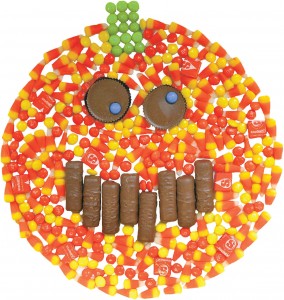By Kelsey Murray –
As kids, we couldn’t wait for Oct. 31. Halloween meant dressing up in our favorite characters, running around in the dark with the other ghouls and goblins, and eating a massive amount of candy.
However, is all this candy making Halloween an unhealthy holiday? According to the US Census Bureau’s latest statistics, Americans, on average, consume about 25 pounds of candy annually. Salve Regina students were eager to let us know what candy they have a sweet tooth for.
“Reese’s,” said both seniors Noelle Lowery and Erin Connolly.
“My favorite Halloween candy is candy corn since it only comes out around this time,” said Jackie Horgan, a senior Elementary and Special Ed major. Other favorites were M&M Minis and Kit Kats.
While most of these Salve students love candy, they recognize how unhealthy it can be and say that this can be solved simply: eat in moderation.
“I wouldn’t say it’s a healthy holiday, but I think if parents allow their kids to eat their candy in moderation then its okay and it should be a fun holiday,” said Sarah Livingston.
Phil Cervelli has a similar opinion, stating, “[Halloween is] healthy if done correctly by not eating too much candy at once,” said Cervelli.
Horgan offers a slightly stricter ruling: “I don’t think it’s a very healthy holiday because trick or treating encourages kids to eat as much candy as they can get,” said Horgan.
So while many believe moderation is the key to staying healthy it can be hard at times to stop craving candy during the holidays.
According to dietitian Gloria Tsang, author of the new book, Go UnDiet: 50 Small Actions for Lasting Weight Loss, and founder of nutrition network HealthCastle.com, choosing the right candy can help. “With big differences in calories, sugar, and quality of ingredients used, it’s just not true that all Halloween candy is the same,” Tsang says. “None of them are exactly good for you, but we’ve done some close analysis of common competitors to see which options are best from a nutrition perspective.”
For those health-conscious candy-lovers in the Salve community, there are ways to pick the best candy for your body. The following are some of the findings of the Health Castle candy analysis:
Pay Day beats Reese Peanut Butter Cups: Reese Cups contain polyglycerol polyricinoleate (PGPR), a commercial emulsifier used to reduce cocoa butter. Plus, Pay Day is the only candy to list peanuts, not sugar, as the first ingredient.
Kit Kat beats Twix: They’re similar in calories and sugar (and both include PGPR), but Twix’s ingredient list is surprisingly long. What’s even more surprising? Twix is marketed as a biscuit topped with caramel and chocolate, but there’s no caramel on the ingredient list.
M&Ms beat Skittles: Both contestants in this classic Halloween showdown contain artificial colorings and wax. M&Ms at least offer a tiny amount of calcium and protein, and less sugar.
Baby Ruth beats Snickers: There’s no real winner here – Snickers has partially hydrogenated oil, and Baby Ruth has high-fructose corn syrup and the preservative TBHQ. Snickers loses out simply because the portion is larger, leaving room for more calories.
Mounds beats Almond Joy: Mounds has a shorter ingredient list, and skips the partially hydrogenated oil found in Almond Joy.
3 Musketeers beats Hershey Milk Chocolate: The Hershey bar has that sneaky PGPR, while 3 Musketeers was unique among the candies surveyed in actually including real Cocoa powder.
Whoppers beat Milk Duds: Milk Duds will stick to your teeth, so they’re a no-no for anyone with dental issues. Plus, the smaller Whoppers serving save some calories.
Happy Eating!














